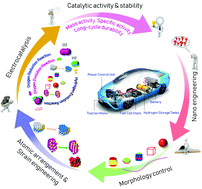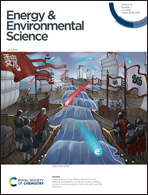Engineering electrocatalyst nanosurfaces to enrich the activity by inducing lattice strain
Abstract
Electrocatalysis undeniably offers noteworthy improvements to future energy conversion and storage technologies, such as fuel cells, water electrolyzers, and metal–air batteries. The molecular interaction between catalytic surfaces and chemical reactants produces a trade-off between catalyst activity and effectiveness, and hence requires optimization. When enhancing electrocatalysis, atomic surface structure tuning is of primary importance in simultaneously meeting demands for electrocatalytic activity and stability. The impact of lattice strain on catalytic activity tuning is experimentally revealed in de-alloyed bimetallic nanoparticles, in which surface distortion makes essential contributions to the activities of state-of-the-art electrocatalysts that vary over distinct sizes, surface defect concentrations, shapes, and atomic compositions under the studied environments. Further, metal-rich shells show compressive strain in core–shell catalyst nanoparticles, yielding shifts in metal electronic band structure features, weakened chemisorption of oxygenated species, and changes in the mechanisms governing catalyst activity. Our study evaluates the practical and fundamental effects of surface distortion and defects on interfacial electrocatalysis, namely in the oxygen reduction reaction (ORR), oxygen evolution reaction (OER), and hydrogen evolution reaction (HER). This is accomplished via an understanding of strain from theory, establishing reactivity–strain relationships that inform the tuning and enhancement of electrocatalytic activity and stability.

- This article is part of the themed collection: Energy and Environmental Science Recent Review Articles


 Please wait while we load your content...
Please wait while we load your content...